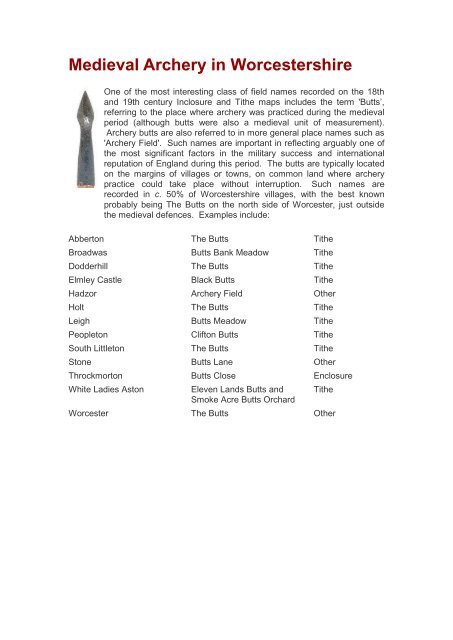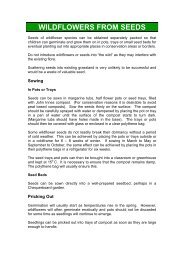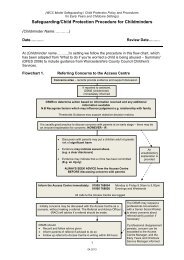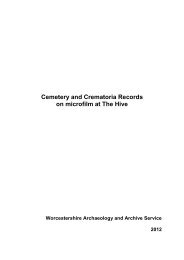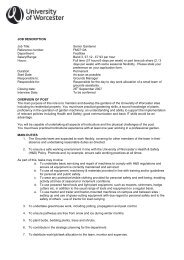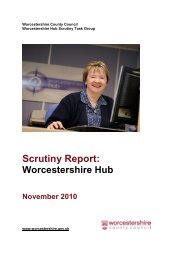Medieval Archery in Worcestershire - Worcestershire County Council
Medieval Archery in Worcestershire - Worcestershire County Council
Medieval Archery in Worcestershire - Worcestershire County Council
Create successful ePaper yourself
Turn your PDF publications into a flip-book with our unique Google optimized e-Paper software.
<strong>Medieval</strong> <strong>Archery</strong> <strong>in</strong> <strong>Worcestershire</strong>One of the most <strong>in</strong>terest<strong>in</strong>g class of field names recorded on the 18thand 19th century Inclosure and Tithe maps <strong>in</strong>cludes the term 'Butts’,referr<strong>in</strong>g to the place where archery was practiced dur<strong>in</strong>g the medievalperiod (although butts were also a medieval unit of measurement).<strong>Archery</strong> butts are also referred to <strong>in</strong> more general place names such as'<strong>Archery</strong> Field'. Such names are important <strong>in</strong> reflect<strong>in</strong>g arguably one ofthe most significant factors <strong>in</strong> the military success and <strong>in</strong>ternationalreputation of England dur<strong>in</strong>g this period. The butts are typically locatedon the marg<strong>in</strong>s of villages or towns, on common land where archerypractice could take place without <strong>in</strong>terruption. Such names arerecorded <strong>in</strong> c. 50% of <strong>Worcestershire</strong> villages, with the best knownprobably be<strong>in</strong>g The Butts on the north side of Worcester, just outsidethe medieval defences. Examples <strong>in</strong>clude:Abberton The Butts TitheBroadwas Butts Bank Meadow TitheDodderhill The Butts TitheElmley Castle Black Butts TitheHadzor <strong>Archery</strong> Field OtherHolt The Butts TitheLeigh Butts Meadow TithePeopleton Clifton Butts TitheSouth Littleton The Butts TitheStone Butts Lane OtherThrockmorton Butts Close EnclosureWhite Ladies AstonEleven Lands Butts andSmoke Acre Butts OrchardTitheWorcester The Butts Other
Throckmorton Inclosure Plan of 1784 overla<strong>in</strong> on a modern aerial photograph,show<strong>in</strong>g the location of 'Butts Close' (copyright <strong>Worcestershire</strong> <strong>County</strong> <strong>Council</strong>)<strong>Archery</strong> butts comprised a level flat area of land, up to 200m long, form<strong>in</strong>g arange along which the archers could shoot. Orig<strong>in</strong>ally they would conta<strong>in</strong> anumber of circular flat-topped, turf-covered target mounds, often arranged <strong>in</strong>pairs. The mounds provided a level platform for the targets and were usuallypositioned at either end of the range. No such mounds have yet been recognised<strong>in</strong> <strong>Worcestershire</strong> but they can vary from between 2m to 8m <strong>in</strong> diameter and are1m to 3m high. The mound may be surrounded by a shallow ditch from which thesoil to build the mound was obta<strong>in</strong>ed. (Information from the English HeritageMonument Class Description.)The survival of the butts, even if only as place-name evidence, reflect animportant aspect of medieval society. <strong>Archery</strong> tra<strong>in</strong><strong>in</strong>g was compulsory for allmales, traditionally start<strong>in</strong>g at the age of seven. A series of statutes passed <strong>in</strong> the14th and 15th centuries banned a large number of field sports and other games<strong>in</strong> order to protect regular archery practice. Edward IV passed a law that everyEnglishman from the age of 16 to 60 should own a longbow (of his own height)and should practise every Sunday after church and on feast days. In 1542 an Actestablished that the m<strong>in</strong>imum target distance for anyone over the age of 24 years
was 220 yards (the modern competition maximum is 80 yards)! A tra<strong>in</strong>ed archercould shoot 12 to 15 arrows per m<strong>in</strong>ute and hit a man-sized target at a m<strong>in</strong>imumof 200 yards. The maximum range of a longbow was about 400 yards.All men from 16 to 60 had a duty to protect the country <strong>in</strong> time of crisis (the possecomitatus). But a levy of archers for military service could also be taken <strong>in</strong> eachcounty from anyone with land or rents worth from £2 to £5 (or they could pay for asubstitute). In 1346 at the battle of Crecy, the English army of Edward III had7,000 to 10,000 archers out of a total strength of 19,000 men.The bow used was the longbow, up to 78” <strong>in</strong> length and made of yew (thefavourite be<strong>in</strong>g Spanish yew), Wych Elm, Elm, or Ash. In 1510, Henry VIIIpurchased 40,000 yew bow staves from the Doge of Venice. The draw weightwas up to a remarkable 120 pounds, with the bow drawn 'to the ear' (rather thanto the corner of the mouth as is common <strong>in</strong> modern archery). The attachmentpo<strong>in</strong>ts for the str<strong>in</strong>g were protected by horn ‘nocks’. There was no arrow rest onthe handle as on modern bows, with the arrow rest<strong>in</strong>g on the <strong>in</strong>dex f<strong>in</strong>ger. Atshort range, an arrow could penetrate 4 <strong>in</strong>ches of seasoned oak, and couldpenetrate the armour of a knight at 200 yards. A nobleman could therefore bekilled by a common man.The use of archery decl<strong>in</strong>ed dur<strong>in</strong>g the 15th century as it became impossible toma<strong>in</strong>ta<strong>in</strong> the strict tra<strong>in</strong><strong>in</strong>g needed to ma<strong>in</strong>ta<strong>in</strong> the strength and skills needed toshoot a longbow. This may partly have been a consequence of a more mobilesociety with a shift of former labourers to the towns. In 1477, Edward IV bannedan early form of cricket because it was thought to be <strong>in</strong>terfer<strong>in</strong>g with regulararchery practice. The <strong>in</strong>vention of the musket <strong>in</strong> 1520 sealed the fate of theweapon. Although the musket had a slower rate of fire, it required far lesstra<strong>in</strong><strong>in</strong>g to use. Archers comprised 17 percent of the late 16th century Tra<strong>in</strong>edBands but <strong>in</strong> 1595 all bows were ordered to be replaced by musket.There was, however, a considerable nostalgic reluctance to give up the weaponand they cont<strong>in</strong>ued to be used <strong>in</strong>to the 17th century. In East Anglia <strong>in</strong> the 1620s itwas even suggested that a return to longbows might so shock <strong>in</strong>vaders from alarger and better-equipped foreign enemy that it would give the smaller EnglishTra<strong>in</strong>ed Bands an edge of surprise! Locally, <strong>in</strong> 1627 there were compla<strong>in</strong>ts thattroops <strong>in</strong> St John’s, Worcester, were not br<strong>in</strong>g<strong>in</strong>g longbows and arrows tomusters or tra<strong>in</strong><strong>in</strong>g with them regularly and there were warn<strong>in</strong>gs from theConstable that the butts at Holt and Cotheridge were ru<strong>in</strong>ous. The parishioners ofNorthfield (then <strong>in</strong> North <strong>Worcestershire</strong>, now outer Birm<strong>in</strong>gham) were betterprepared. In 1620 they spent 4d on repair<strong>in</strong>g the Butts and <strong>in</strong> 1623 built a newset at a cost of 1s. In 1628-9 the Statute of Henry VIII requir<strong>in</strong>g archery practicewas restored and as late as 1633 Charles I issued an new order for the use ofbows <strong>in</strong> the Tra<strong>in</strong>ed Bands, with tra<strong>in</strong><strong>in</strong>g to be provided by a master bowman.Indeed, a company of pikemen also armed with bows (the ‘double-armed man’)was formed <strong>in</strong> Herefordshire <strong>in</strong> 1642. But despite such efforts, the age of thelongbow had passed <strong>in</strong>to that of gunpowder and longbows saw little servicedur<strong>in</strong>g the Civil Wars, except <strong>in</strong> the Scottish army.
From its orig<strong>in</strong> <strong>in</strong> military service, archery developed as a sportfrom the 16th century. Henry VIII started a number of sport<strong>in</strong>garchery groups – protect<strong>in</strong>g them aga<strong>in</strong>st prosecution fromaccidentally shoot<strong>in</strong>g passers-by! The ‘The Society of F<strong>in</strong>sbury<strong>Archery</strong>’, was founded by at least 1594.Further Onl<strong>in</strong>e ResourcesBadm<strong>in</strong>ton Library: <strong>Archery</strong>Mary Rose archery f<strong>in</strong>dsLa Belle Compagnie'A Shot In Time' (Brief History of<strong>Archery</strong>)Society for the Promotion of Traditional<strong>Archery</strong>Articles from the Society of Archer-Antiquaries


